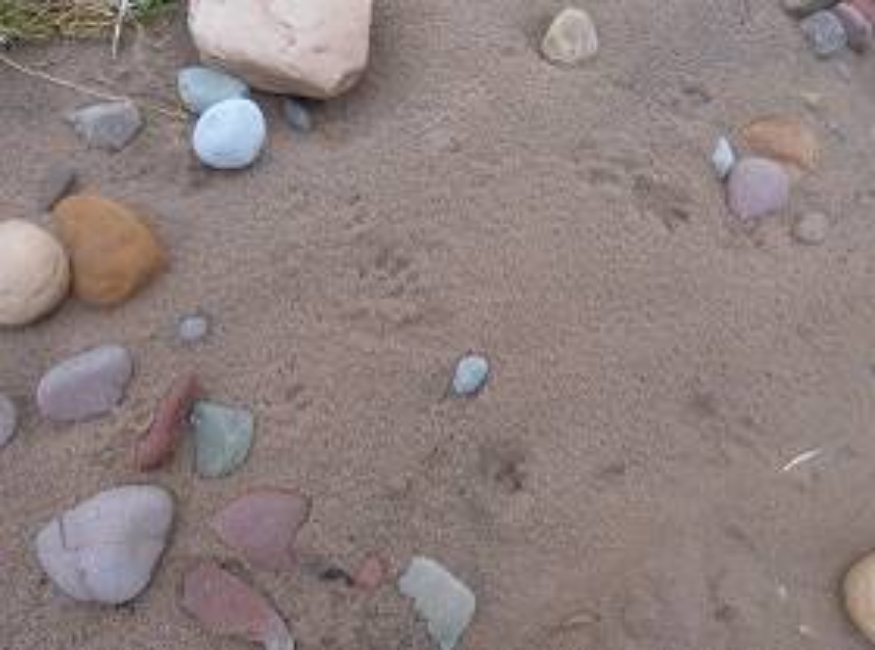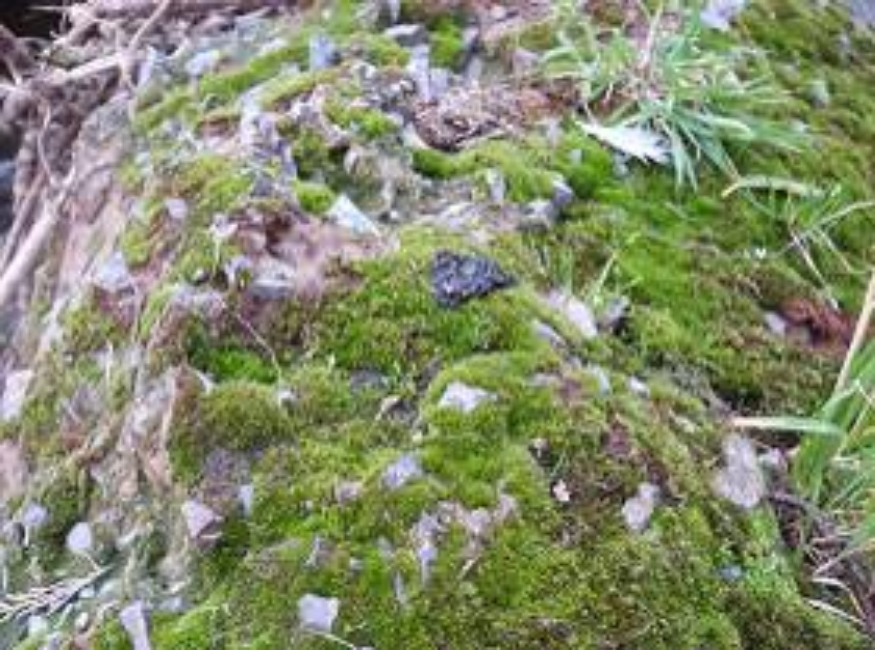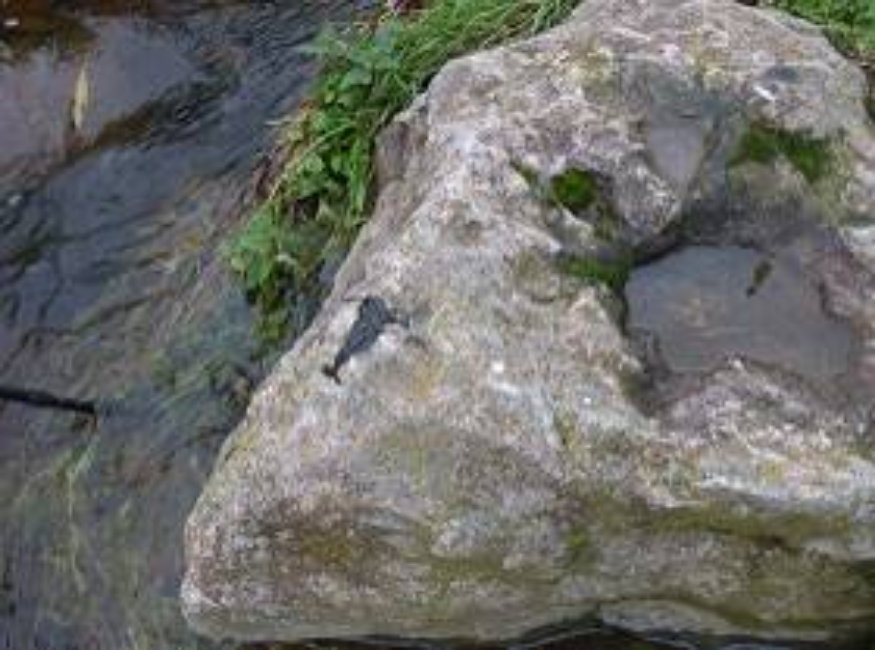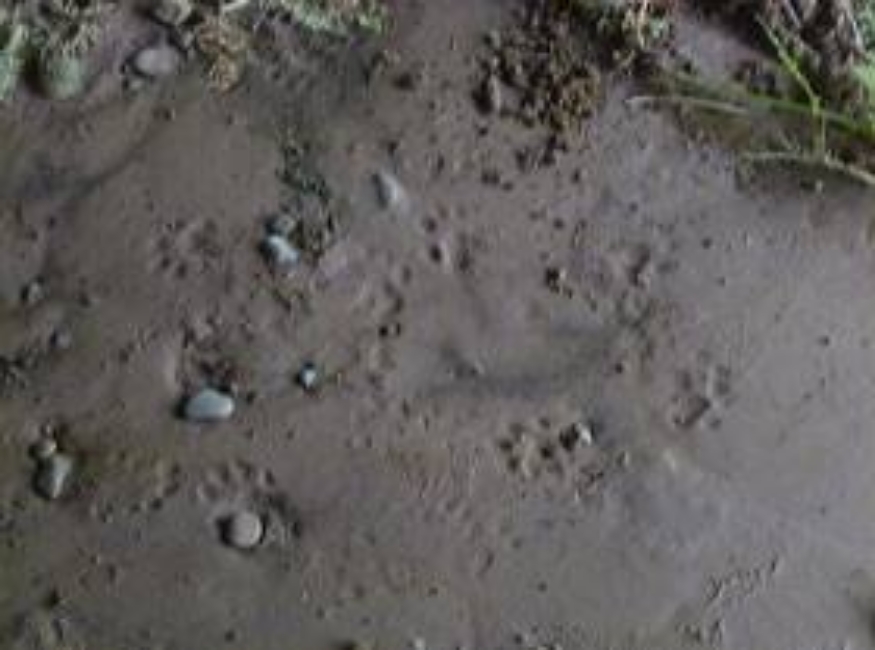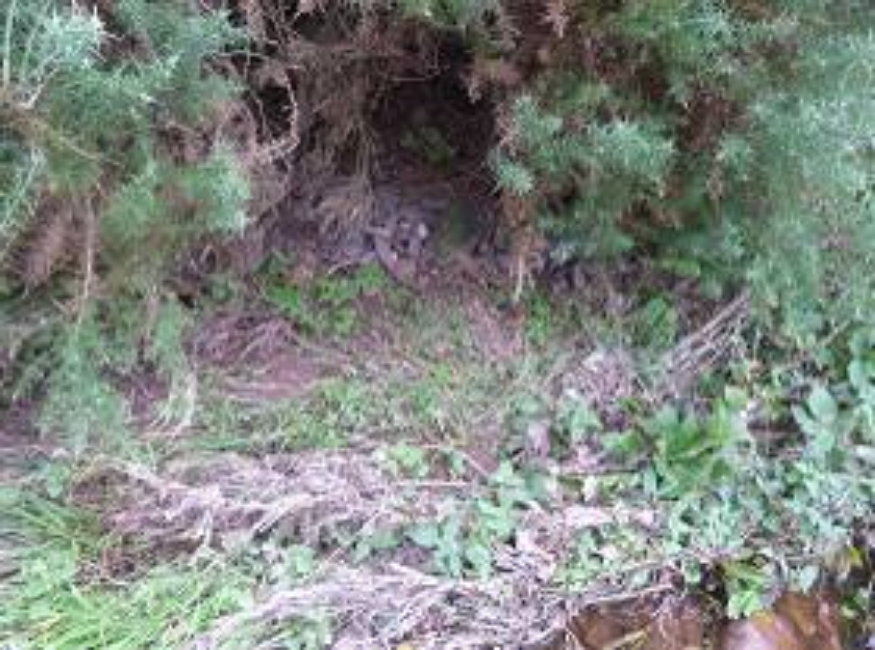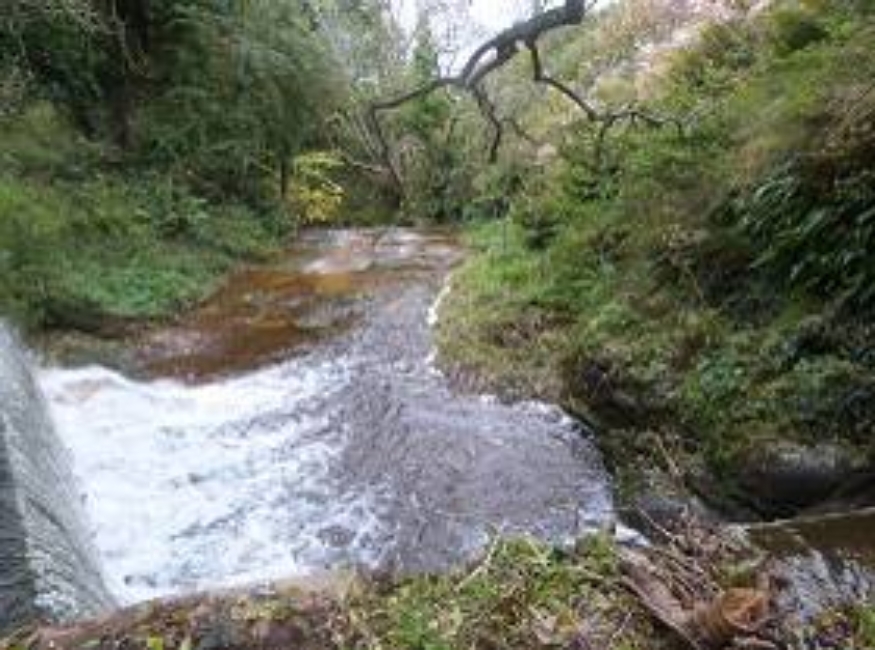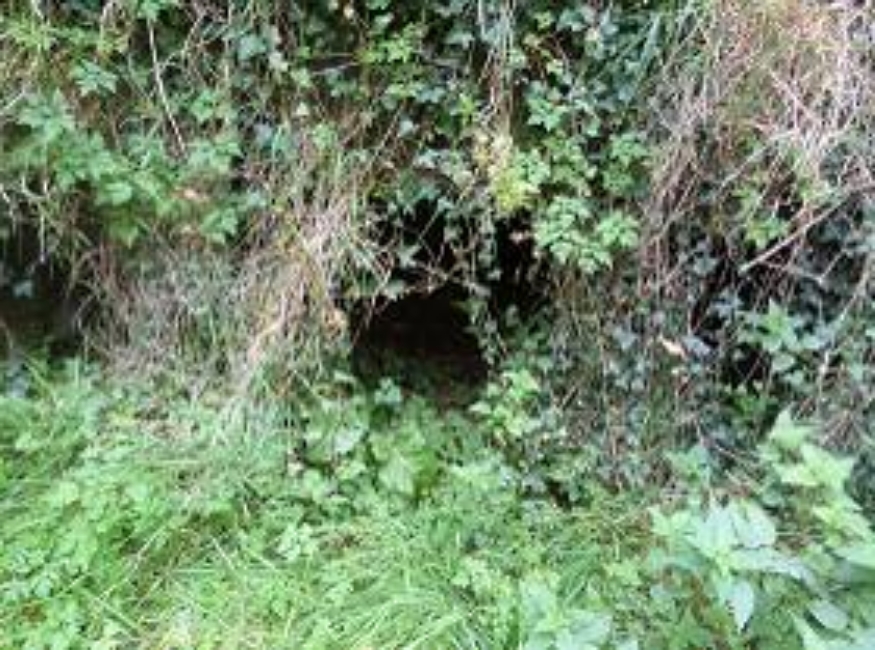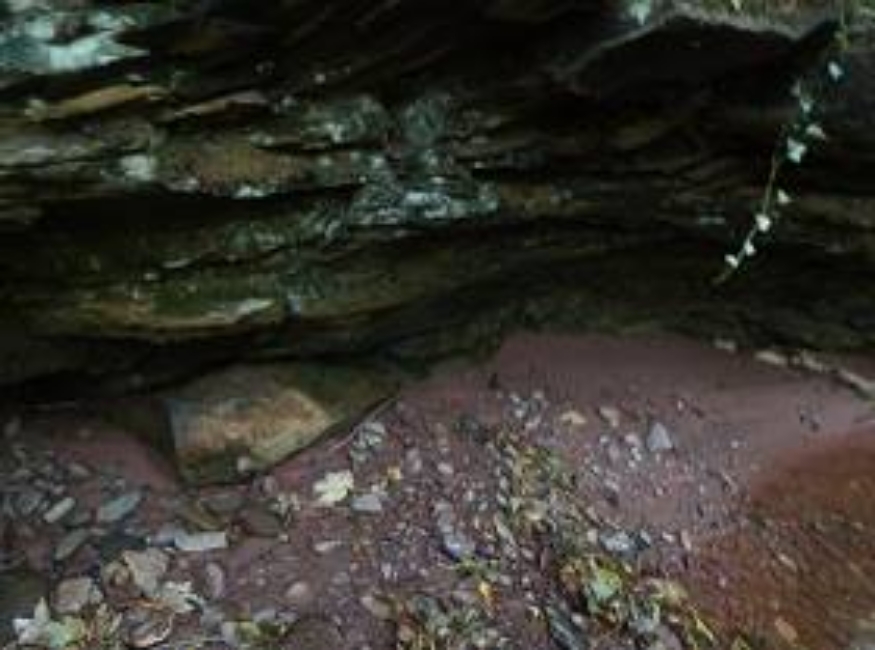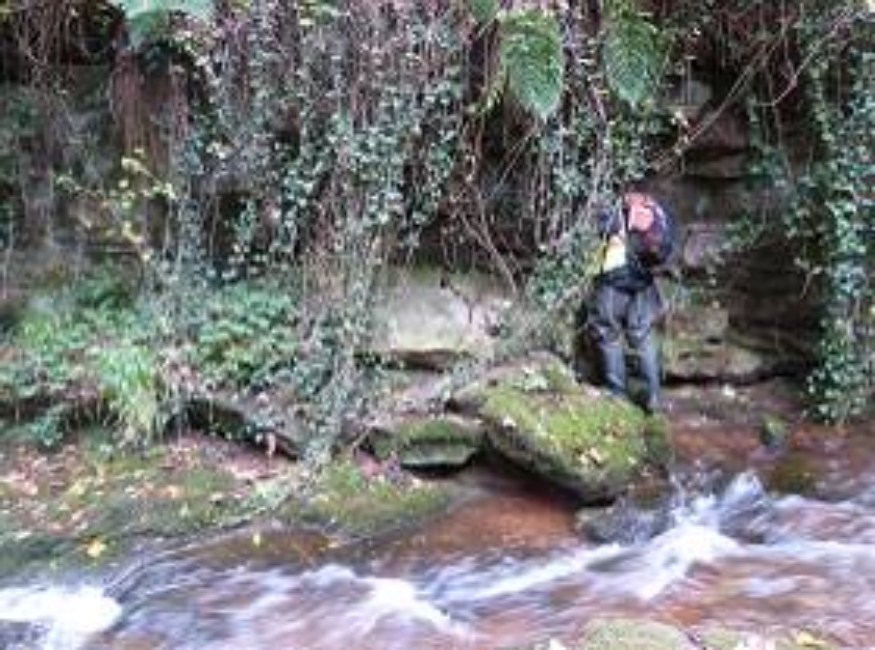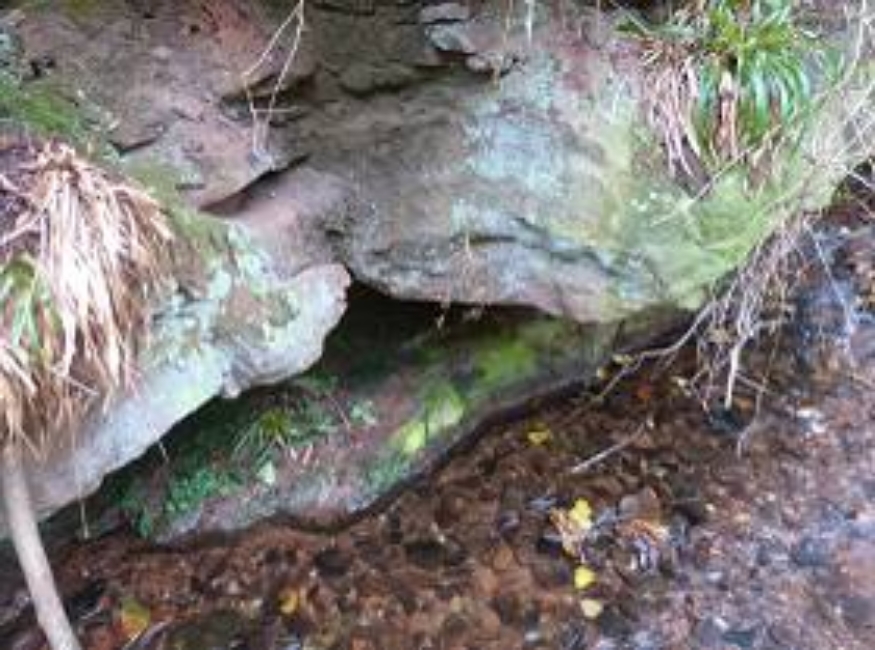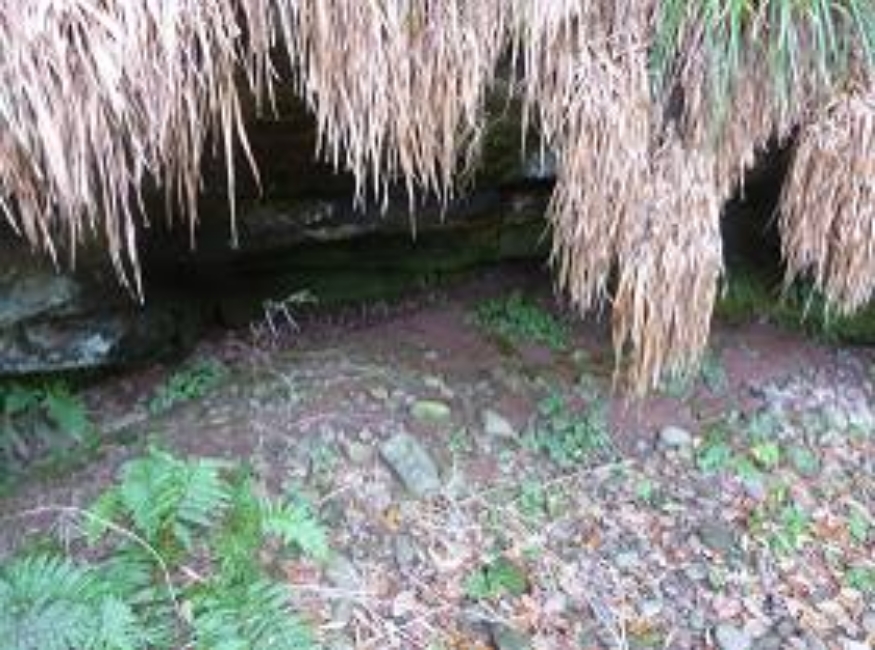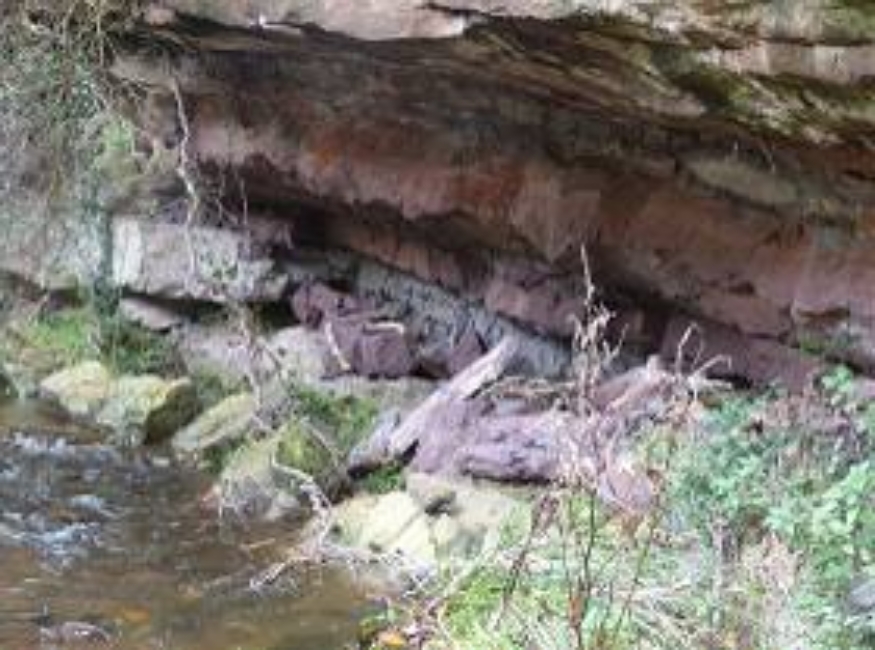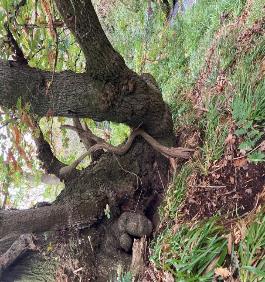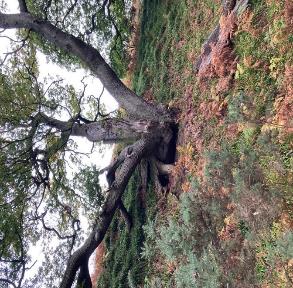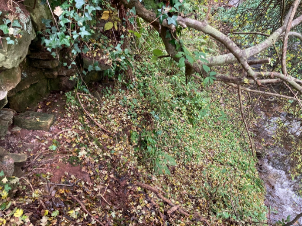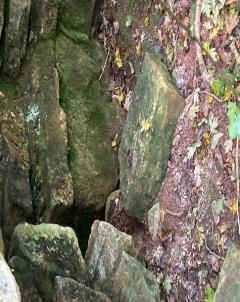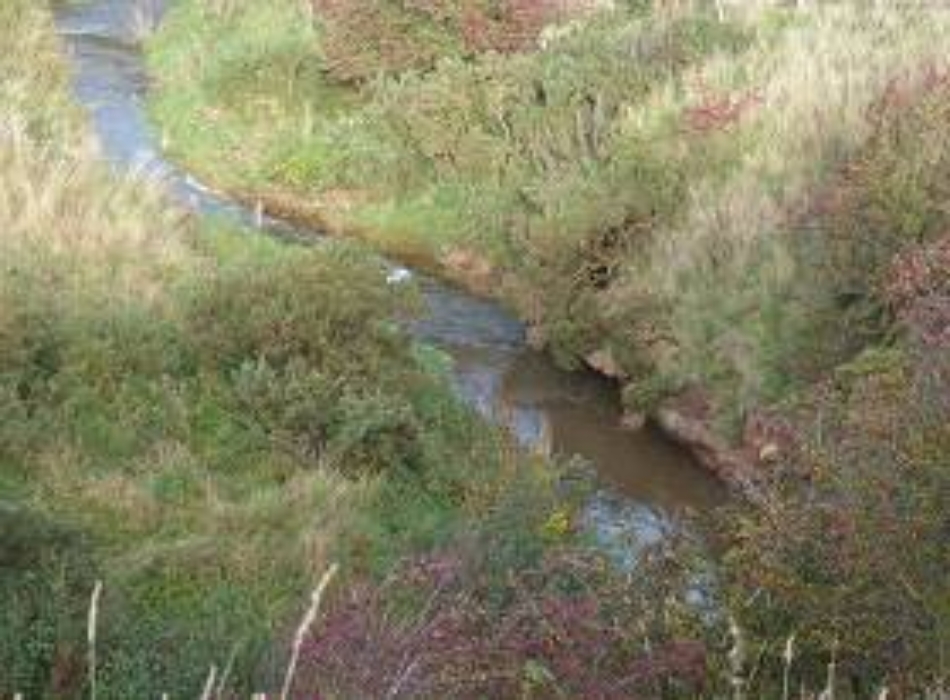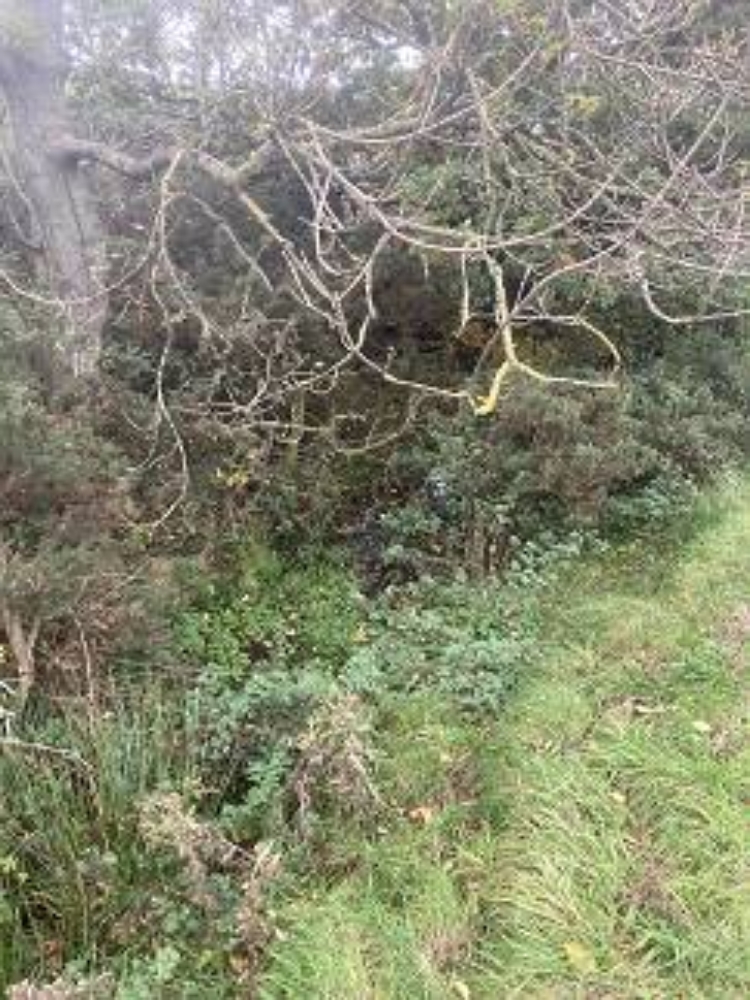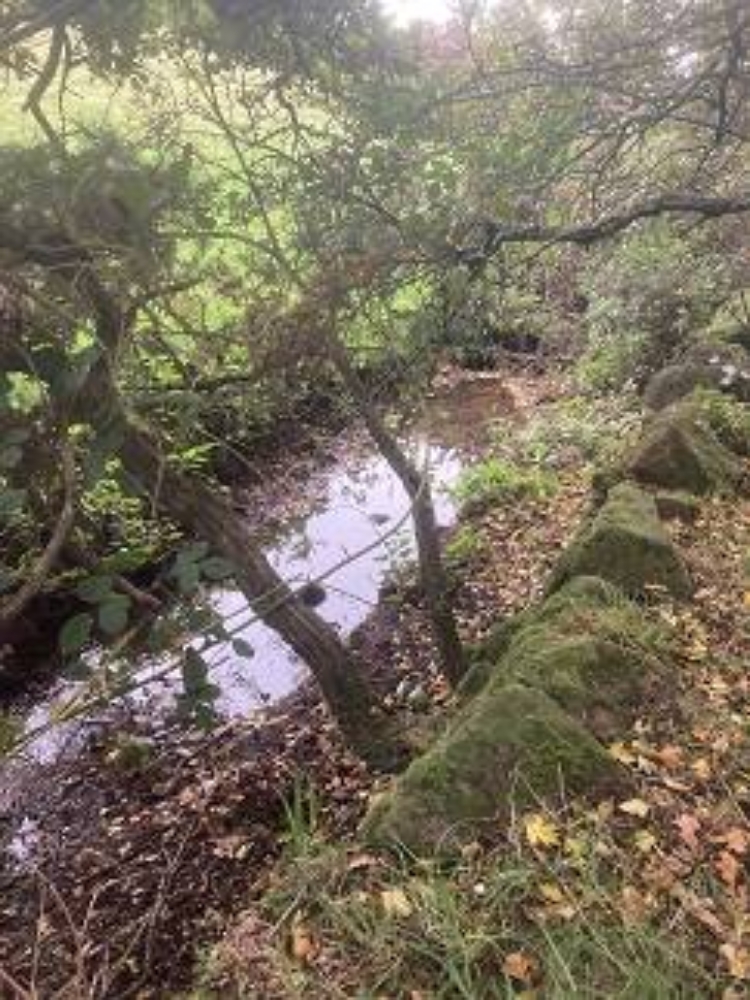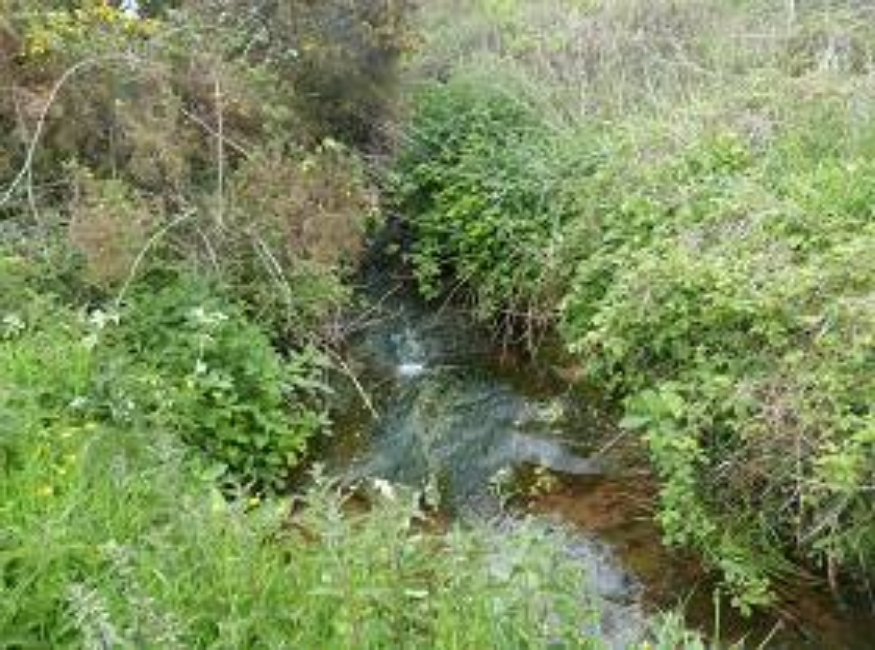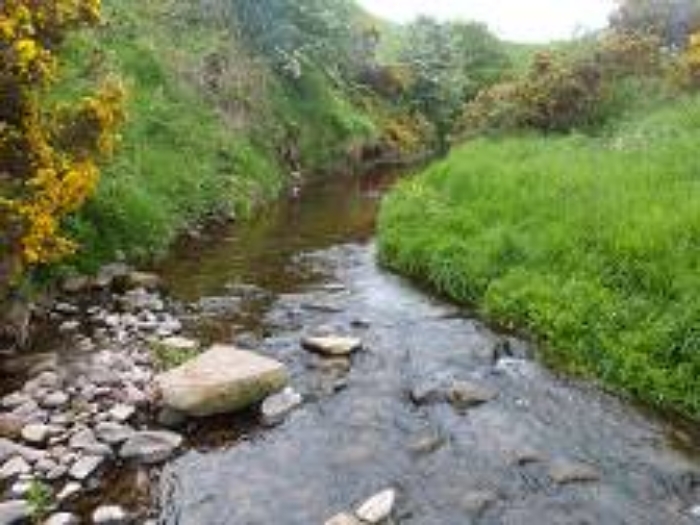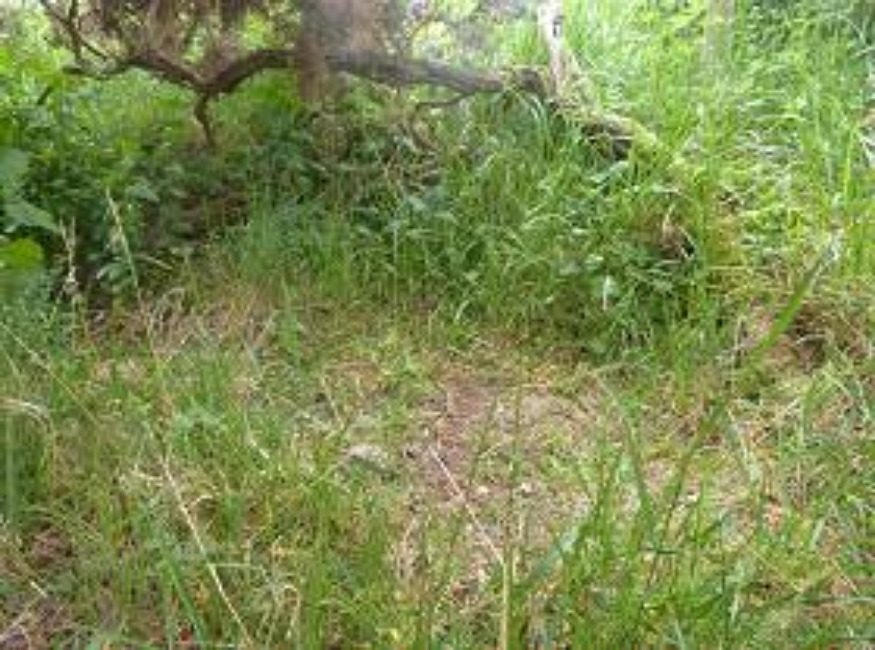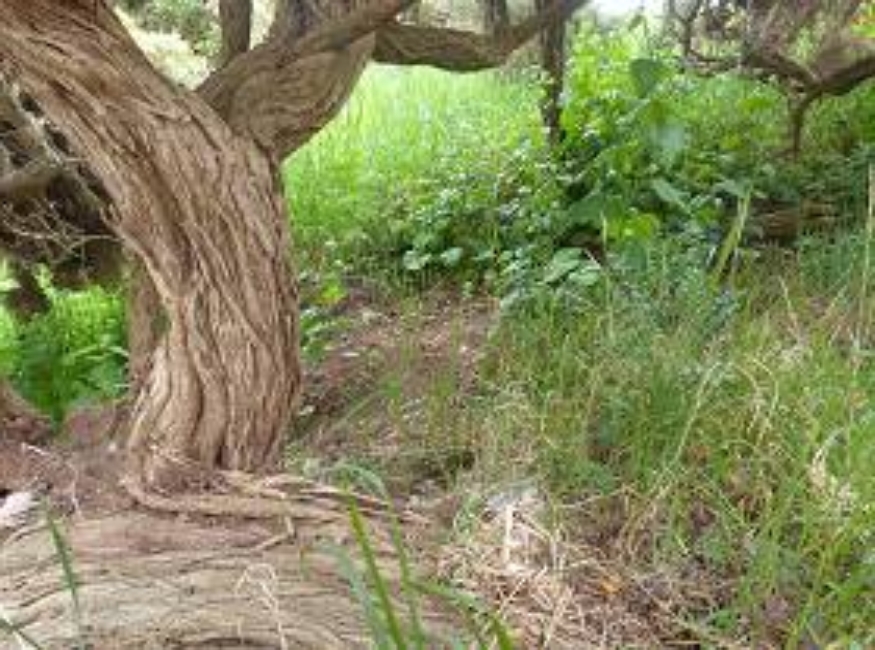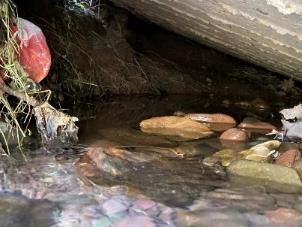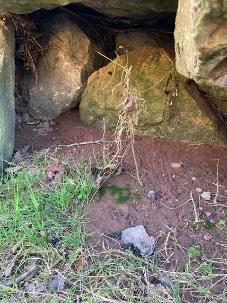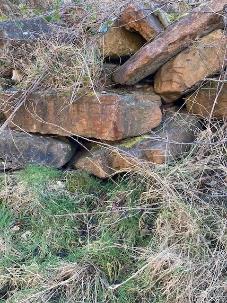5.3 Water Vole
The survey found no evidence of water vole within the Study Area and watercourses were considered to be generally suboptimal for this species. No further consideration of water vole is required.
5.4 Great Crested Newt
The eDNA survey confirmed the presence of great crested newt within a pond that lies 315 m south-west of the Site. The pond is located 450 m from the footprint of the Proposed Development at its nearest point. Suitable terrestrial habitat links the pond to the southern boundary of the Site, along the Ogle Burn and Braidwood Burn corridor. However, the works footprint across the Braidwood Burn corridor is over 500 m from the pond, which is generally considered to be the maximum distance great crested newts will migrate from their breeding ponds (Langton et al., 2001). Where the works footprint extends 50 m into the 500 m buffer, the habitat is improved grassland, which is suboptimal for this species. In consultation with NatureScot, it has been agreed that newt fencing is to be installed to separate the works area from suitable great crested newt habitat to the south of the proposed Branxton substation. This will protect individual newts by acting as a barrier to movement of newts into the works area. The location, extent and design of newt fencing is detailed within Technical Appendix 7.4 - Great Crested Newt Species Protection Plan.
5.5 General Best Practice Measures
It is recommended that the following good practice measures, endorsed by NatureScot, are applied during construction activity (SNH, 2019):
Cover/fence-off excavations, or provide escape ramps at the end of the working day to avoid animals becoming trapped (if an animal does become trapped, advice should be sought immediately from SNH);
Cap any temporarily exposed pipe systems out of work hours;
Clean fuel/chemical spillages immediately with spill kits and dispose of waste materials correctly;
Ensure artificial lighting used on Site is minimised, or that lighting units are hooded and directed away from edge habitat;
Avoid unnecessary disturbance to habitats by minimising the extent of ground clearance, as far as possible; and
Ecological toolbox talks to be given to all new site personnel as part of the site induction process on the potential presence of protected species including badgers, otters and great crested newts and any measures that need to be undertaken should such species be discovered during construction activities.
6. References
ARG UK (2010). Amphibian and Reptile Groups of the United Kingdom, ARG UK Advice Note 5: Great Crested Newt Habitat Suitability Index. Available online at: https://www.arguk.org/info-advice/advice-notes/9-great-crested-newt-habitat-suitability-index-arg-advice-note-5/file (accessed March 2022).
Chanin P (2003). Monitoring the Otter Lutra lutra. Conserving Natura 2000 Rivers Monitoring Series No. 10. English Nature, Peterborough.
CIEEM (2013a). Competencies for Species Survey: Badger. Available online at https://cieem.net/wp-content/uploads/2019/02/CSS-BADGER-April-2013.pdf (accessed March 2022).
CIEEM (2013b). Competencies for Species Survey: Eurasian Otter. Available online at: https://cieem.net/wp-content/uploads/2019/02/CSS-EURASIAN-OTTER-April-2013.pdf (accessed March 2022).
CIEEM (2013c). Competencies for Species Survey: Water Vole. Available online at: https://cieem.net/wp-content/uploads/2019/02/CSS-WATER-VOLE-April-2013.pdf (accessed March 2022).
CIEEM (2013d). Competencies for Species Survey: Great Crested Newt. Available online at: https://cieem.net/wp-content/uploads/2019/02/CSS-GREAT-CRESTED-NEWT-April-2013.pdf (accessed March 2022).
Dean M, Strachan R, Gow D and Andrews R (2016). The Water Vole Mitigation Handbook (Mammal Society Mitigation Guidance Series). Matthews, F and Chanin, P Eds, Mammal Society, London.
ITPEnergised (2022a). Berwick Bank EIA, Ecology Chapter, Technical Appendix 7.1, Preliminary Ecological Appraisal. ITPEnergised, Edinburgh.
ITPEnergised (2022b). Berwick Bank EIA, Ecology Chapter, Technical Appendix 7.3, Bats. ITPEnergised, Edinburgh.
Langton TES, Beckett CL and Foster JP (2001). Great Crested Newt Conservation Handbook, Froglife, Halesworth.
Oldham RS, Keeble J, Swan MJS and Jeffcote M (2000). Evaluating the suitability of habitat for the great crested newt (Triturus cristatus). Herpetological Journal. 10: 143-155.
Scottish Badgers (2018). Surveying for Badgers: Good Practice Guidelines. Version 1. Available at: https://www.scottishbadgers.org.uk/userfiles/file/planning_guidelines/Surveying-for-Badgers-Good-Practice-Guidelines_V1.pdf (accessed March 2022).
Scottish Government (2013). Scottish Biodiversity List. Version 1.5. Available online at: http://www.gov.scot/Topics/Environment/Wildlife-Habitats/16118/Biodiversitylist/SBL (accessed February 2022).
SNH (2018). Licensing Guidance. Scottish Natural Heritage (now NatureScot). Available online at: https://www.nature.scot/sites/default/files/2018-04/Guidance-Licensing-Badgers-Current-use.pdf (accessed November 2020).
SNH (2019). Protected Species Advice for Planning Consultants: Badger. Scottish Natural Heritage (now NatureScot). Available online at: https://www.nature.scot/sites/default/files/2019-10/Species%20Planning%20Advice%20-%20badger.pdf (accessed March 2022).
TWIC (2021). The Wildlife Information Centre. Notable Species List. Received January 2021.
Annexes
Annex A: Species Specific Legislation
Badger
Badgers and their setts are protected under the Protection of Badgers Act 1992, as amended by the Wildlife and Natural Environment (Scotland) Act 2011. Under this legislation it is an offence to intentionally or recklessly:
Kill, injure, take, possess or cruelly ill-treat a badger or attempt to do so;
Interfere with a sett by damaging or destroying it;
Obstruct access to a badger sett;
Disturb a badger whilst it is occupying a sett;
Cause or allow a dog to enter a sett;
Sell a live badger, or offer one for sale, or possess a live badger; and
Be in the possession, or control of, a dead badger or anything derived from a dead badger.
Under the Protection of Badgers Act 1992, a badger sett is defined as ‘any structure or place which displays signs indicating current use by a badger’. Following NatureScot guidance, in the absence of any case law to define current use, the presence of field signs such as bedding, fresh spoil heaps, signs of recent digging, hair, latrines, or footprints in or around the potential sett or evidence of badgers entering or exiting the structure or place in question would indicate current use of the structure / place by a badger (SNH, 2018). Where a possible sett has no immediate evidence of current use, and is to be impacted by works, the structure should be actively monitored for a minimum of two weeks.
This legislation means that badgers are fully protected in Scotland, and that any planned activity, which may affect them, requires prior consultation with the appropriate statutory nature conservation organisation (i.e. NatureScot). Under Section 10 (1) of The Protection of Badgers Act 1992, licences may be granted by NatureScot for certain purposes that would otherwise be illegal.
Otter
Otter is a European Protected Species, protected under the Conservation (Natural Habitats, &c.) Regulations 1994. As such, in Scotland it is an offence to deliberately or recklessly:
Capture, injure or kill an otter;
Harass an otter or group of otters;
Disturb an otter in a den or any other structure or place it uses for shelter or protection;
Disturb an otter while it is rearing or otherwise caring for its young;
Obstruct access to a den or other structure or place otters use for shelter or protection, or otherwise deny the animal use of that place;
Disturb an otter in a manner or in circumstances likely to significantly affect the local distribution or abundance of the species; and
Disturb an otter in a manner or in circumstances likely to impair its ability to survive, breed or reproduce, or rear or otherwise care for its young.
It is also an offence to:
Damage or destroy a breeding site or resting place of such an animal (whether deliberately or recklessly); and
Keep, transport, sell or exchange, or offer for sale or exchange any wild otter (or any part or derivative of one) obtained after 10 June 1994.
It should be noted that otter shelters are always legally protected, whether an otter is present or not.
Otter is also included on the Scottish Biodiversity List (Scottish Government, 2013), where it is listed for avoidance of negative impacts.
Water Vole
Water vole receives partial protection through its listing on Schedule 5 of The Wildlife and Countryside Act 1981 (as amended). In Scotland, this legal protection is currently restricted only to the water vole places of shelter or protection; it does not extend to the animal itself. It is an offence to intentionally or recklessly:
Damage, destroy or obstruct access to any structure or place that water voles use for shelter or protection; or
Disturb a water vole while it is using any such place of shelter or protection.
Water vole is a Priority Species on the Scottish Biodiversity List (Scottish Government, 2013), where it is listed for both conservation action and for avoidance of negative impacts. This species has suffered significant declines in recent decades, mainly due to habitat loss and degradation, population fragmentation and predation by American mink (Mustela vison).
Great Crested Newt
Great crested newt is a European Protected Species, protected under the Conservation (Natural Habitats, &c.) Regulations 1994. As such, in Scotland it is an offence to deliberately or recklessly:
Capture, injure or kill a great crested newt;
Harass a great crested newt or group of great crested newts;
Disturb a great crested newt in a structure or place it uses for shelter or protection;
Disturb a great crested newt while it is rearing or otherwise caring for its young;
Obstruct access to a structure or place great crested newt use for shelter or protection, or otherwise deny the animal use of that place;
Disturb a great crested newt in a manner or in circumstances likely to significantly affect the local distribution or abundance of the species;
Disturb a great crested newt in a manner or in circumstances likely to impair its ability to survive, breed or reproduce, or rear or otherwise care for its young;
Disturb a great crested newt while it is migrating or hibernating; and
Take or destroy the eggs of a great crested newt.
It is also an offence of strict liability to:
Damage or destroy a breeding site or resting place of such an animal (whether deliberately or recklessly). These sites and places are protected even when the animal isn’t present. For example, great crested newt ponds are protected all of the time as long as it can be shown that the newts use the ponds some of the time; and
Keep, transport, sell or exchange, or offer for sale or exchange any wild otter (or any part or derivative of one) obtained after 10 June 1994.
Great crested newt is also included on the Scottish Biodiversity List (Scottish Government, 2013), where it is listed for avoidance of negative impacts.
Annex B: Target Notes
Table B1: Survey Target Notes
Target Note | Grid Reference | Feature | Description |
|---|---|---|---|
1 | NT 75257 74218 | Footprints |
15.10.2021 - Otter prints at mouth of Thornton Burn. Prints identified appear to be of multiple animals with smaller and larger prints indicating a potential family group (e.g. adult female and young). |
2 | NT 75174 74212 | Spraint | 15.10.2021 - Numerous fresh spraints on rock in Thornton Burn considered to be less than one week old. |
3 | NT 75160 74211 | Spraint | 15.10.2021 - Large fresh spraint on rock in Thornton Burn considered to be less than one week old. |
4 | NT 75130 74199 | Potential hover |
15.10.2021 - Potential resting site (hover) beneath nettle cover on north bank of Thornton Burn. Earth was well worn indicating recent use and a number of fresh spraints were found on rocks close-by. |
5 | NT 75054 74215 | Spraint | 15.10.2021 - Fresh spraint on rock close to north bank of Thornton Burn, less than one week old. |
6 | NT 75032 74191 | Spraint | 15.10.2021 - Fresh spraint on rock on Thornton Burn, less than one week old |
7 | NT 74866 74195 | Footprints |
Otter prints, marker spraint and sign heaps found beneath A1 road bridge over Thornton Burn. Trail cameras recorded otter commuting past on two separate days over a period of five days indicating this is a frequently used route. |
8 | NT 74517 74204 | Potential hover |
15.10.2021 - Potential otter resting site (hover) on south bank of Thornton Burn, slide into water and recently compressed vegetation and earth. No other field sign found. |
9 | NT 74231 74097 | Spraint | 15.10.2021 - Fresh spraint on rock in Thornton Burn. |
10 | NT 73791 74043 | Habitat |
Weir running through woodland. However, not considered to be a barrier to otter terrestrial movement. |
11 | NT 73831 74083 | Potential hover |
15.10.2021 - Potential otter hover on south bank of Thornton Burn with path leading into an area of compressed vegetation and earth. No other field sign found. |
12 | NT 73679 74043 | Potential hover |
15.10.2021 - Potential otter resting site (hover) located on south bank of Thornton Burn with old spraint more than four weeks old found on rocks inside. |
13 | NT 73623 73973 | Potential hover |
15.10.2021 - Potential otter resting site (hover) located on south bank of Thornton Burn with old spraint more than four weeks old found on one rock. |
14 | NT 73463 73553 | Potential hover |
15.10.2021 - Potential otter resting site (hover) located on south bank of Thornton Burn with old spraint more than four weeks old found on one rock. |
15 | NT 73480 73550 | Potential hover |
15.10.2021 - Potential otter resting site (hover) located on south bank of Thornton Burn with old spraint more than four weeks old found on one rock at entrance. |
16 | NT 73379 73066 | Hover |
22.10.2021 - Otter resting site (hover) with three spraint found on south bank of the Ogle Burn, one recent less than one week old and two considered to be older than four weeks old. |
17 | NT 73129 73315 | Potential hover |
22.10.2021 - Potential otter resting site (hover) located on south bank of Braidwood Burn with one spraint considered to be older than two weeks and feeding remains including fish scales and feathers. |
18 | NT 73257 73338 | Potential hover |
22.10.2021 - Potential otter resting site (hover) located on south bank of the Braidwood Burn with recent spraint considered to be less than two weeks old |
19 | NT 73350 73298 | Potential hover |
22.10.2021 - Potential otter resting site (hover) located on south bank of the Braidwood Burn with four old spraint considered to be older than four weeks |
20 | NT 73301 72886 | Potential hover |
22.10.2021 - Potential otter resting site (hover) located on west bank of the Ogle Burn approximately ten meters up the bank within roots of mature oak. The root structure provides a substantial sheltered resting place and the earth within is smoothed indicating mammal use. Highly likely to be used by otter, though no spraint present to indicate current use. |
21 | NT 73268 72836 | Potential hover |
22.10.2021 - Potential otter resting site (hover) located on west bank of Ogle Burn approximately 12 meters up the bank within roots of mature oak. Like TN21, the root structure provides a substantial sheltered resting place and the earth within is smoothed indicating mammal use. Highly likely to be used by otter, though no spraint present to indicate current use. |
22 | NT 73587 73215 | Potential hover |
22.10.2021 - Potential otter resting site (hover) located on south bank of Thornton Burn approximately ten meters up steep bank at base of stone structure. One old spraint present on stone and mammal paths leading to the area through the bankside vegetation. |
23 | NT 73356 75543 | Habitat |
22.10.2021 - Top-down view of Dry Burn indicating poor water clarity due to high levels of silt and clay runoff after recent heavy rainfall. |
24 | NT 74366 672835 | Habitat |
22.10.2021 - Branxton Burn was found to be overgrown at the southern end. The watercourse was shallow in this area <20 cm deep and the channel was c.1 m with no evidence of otter using it as a commuting or foraging route. |
25 | NT 74728 73294 | Habitat |
22.10.2021 - Branxton Burn is fed primarily from field runoff and during the time of survey the burn was very slow-flowing and in areas where it widens out to >1 m often becoming standing water with limited movement. No evidence of otter or water vole was found on the burn during the survey. |
26 | NT 73428 75390 | Habitat |
Tributary running into Dry Burn 2 m wide, 10 cm deep, gradual flow. |
27 | NT 73345 75534 | Habitat |
Tributary connecting to Dry Burn, no evidence of otter or water vole. |
28 | NT 73306 75506 | Habitat |
Good otter habitat within Dry Burn, clear water stream with channel width of 3 m and water depth of 5 cm with a rock/stone channel bed. |
29 | NT 72951 75596 | Potential hover |
23.10.2021 - Gorse layup area with slide but no territorial markings and spraint to confirm this is otter. Potential hover. |
30 | NT 72656 75584 | Spraint | 23.10.2021 - Bridge with old spraint on rocks at south side of watercourse considered more than 3 weeks old as they are dry and fragmented with fish bones clearly visible. |
31 | NT 72644 75452 | Spraint | 23.10.2021 - Otter spraint on rocks under bridge at south side of Dry Burn. Considered more than 3 weeks old as they are dry and fragmented. |
32 | NT 72389 75237 | Spraint | 23.10.2021 - Dry and fragmented spraint on rock old more than 3 weeks old at north side of Dry Burn. |
33 | NT 72229 75193 | Spraint | 23.10.2021 - Very fragmented dry spraint on rock found at north side of Dry Burn. Considered older than 3 weeks. |
34 | NT 72647 75464 | Spraint | 04.02.2022 - Fresh otter spraint on rock. |
35 | NT 72634 75438 | Spraint | 04.02.2022 - Old spraint on rock. |
36 | NT 72629 75431 | Potential holt or hover |
|
37 | NT 72424 75240 | Spraint | 04.02.2022 Old spraint on rock. |
38 | NT 72262 75204 | Spraint | 04.02.2022 Large, fresh spraint on rock. |
39 | NT 72253 75200 | Spraint | 04.02.2022 Otter spraint on fake grass turf on rock. |
40 | NT 72189 75181 | Spraint | 04.02.2022 Otter spraint on rock. |
41 | NT 72146 75174 | Spraint | 04.02.2022 Otter spraint on rock. |
42 | NT 72041 75145 | Active hover |
04.02.2022 Hover on east bank under boulders. Spraint of all ages and sign heap. |
43 | NT 72003 75141 | Potential holt |
04.02.2022 Potential resting site (holt) on east bank, tunnel extends back into boulders, bedding like material visible at back. Further trail camera monitoring between 18.03 – 01.04.22 found no evidence that this feature is used by otter. |
44 | NT 71984 75134 | Spraint | 04.02.2022 Otter spraint on rock. |
45 | NT 71974 75138 | Potential holt |
04.02.2022 Potential resting site (holt) - behind gabion baskets on east bank. The back of the baskets is scoured out and there is a tunnel into bank. Just large enough for otter. Further trail camera monitoring between 18.03 – 01.04.22 found no evidence that this feature is used by otter. |
46 | NT 71883 75146 | Spraint | 04.02.2022 Otter spraint on rock. |
47 | NT 71809 75152 | Spraint | 04.02.2022 Otter spraint on rock. |
48 | NT 71749 75109 | Spraint | 04.02.2022 Otter spraint throughout culvert under A1. |
